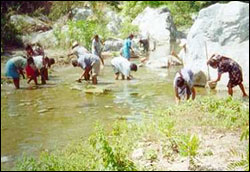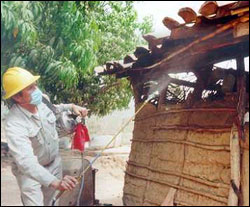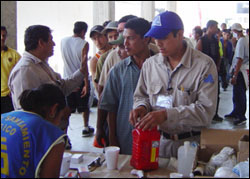 |
Mexico fights malaria, successfully.
|
|
Insecticide Spraying Team, Mexico.
(Courtesy:
Mexico Ministry of Health) |
 |
 |
 |
 |
Community members (here, in Oaxaca State)
removing aquatic algae that favor the breeding of larvae of Anopheles
pseudopunctipennis, a mosquito that can transmit malaria; removal of breeding
sites is a component of malaria control in Mexico.
(Courtesy:
Mexico Ministry of Health) |
 |
Mexico, the third largest country in Latin America, has made substantial inroads
in decreasing its malaria burden.
- Between 1985 and 2003, the numbers of reported cases decreased by 97%, to 3,819
cases in 2003.
- No death attributed to malaria has been reported since 1982.
- Most cases occur in foci found mainly at the country's southern borders, and in
four Northwest states (Sinaloa, Durango, Chihuahua, and Sonora) where difficult
access hinders control activities.
- Practically all cases are due to Plasmodium vivax; only 1% of cases are
caused by P. falciparum, the species that can cause severe malaria.
- To date no drug resistance has been reported.
- 17 of the country's 32 states have not reported any case of malaria during the
past 4 years, and are in the process of being certified as having eliminated malaria.
 |
 |
Insecticide spraying is a valuable tool for
fighting malaria outbreaks in Mexico.
(Courtesy: Mexico Ministry
of Health) |
 |
 |
Eventual elimination of malaria countrywide does not appear to be an unrealistic
goal anymore.
Mexico's success is attributed to a strategy applied since the 1990's, consisting of
intensive surveillance and focused, combined interventions in areas where transmission
is identified. In such areas, patients and their families are treated repeatedly with
antimalarial drugs; breeding sites for mosquito larvae are destroyed or treated; and
pyrethroid insecticides are sprayed as needed, inside houses and outdoors.
Intensive surveillance is a key activity:
- Due to Mexico's climatic conditions, many areas are suitable to malaria transmission
and outbreaks may occur if cases are not treated promptly before the parasites spread
further.
- Population movements from countries south of Mexico with higher malaria endemicity
(and some with chloroquine-resistant P. falciparum) represent a continuous
risk of introduction of malaria parasites.
- While the burden of disease may be relatively low, malaria may still affect Mexico's
economy; for example, outbreaks in tourist areas may impact a major asset of Mexico's
economy.
More on Malaria in Mexico
 |
 |
 |
Undocumented migrant workers transiting
through a shelter in Orizaba (Veracruz State) receive malaria treatment
(chloroquine and primaquine) if they are febrile. This aims to prevent the
introduction of malaria into Mexico, from countries more to the South. Many of
these migrant workers proceed further North, into the United States.
(Courtesy: Mexico Ministry of Health) |
 |
Malaria in Mexico is of concern to the United States:
- Persons migrating from Mexico may introduce malaria into the U.S.
- Mexico is one the most popular vacation destinations for U.S. travelers: 17-19
million U.S. residents travel to Mexico every year; of these, an estimated 2 million
visit malaria-risk areas and should take prophylaxis.
- Travelers who have been exposed to malaria are deferred from blood donation in the
U.S. for 1 to 3 years; thus, travels to Mexico could result in a substantial loss to
the U.S. blood donor pool.
Thus elimination of malaria in Mexico would also benefit the U.S.
Travelers to Mexico should keep malaria in mind:
- Though most resorts and vacation spots in large urban areas are free from malaria,
newer resorts being built in more scenic rural locales may be in malaria risk areas.
- Many of the popular ruin sites which are frequently visited by tourists may be in
risk areas.
- Therefore, it is necessary to know what region of the country your travel itinerary
will include.
 |
 |
Some tourist destinations in Mexico are in
malaria risk areas; tourists visiting such destinations should take appropriate
precautions. For example, archeological sites may be surrounded by rural areas
with potential malaria risk.
(Courtesy: Mexico Ministry of Health) |
 |
 |
CDC's Travelers' Health provides detailed information on
malaria risk in Mexico (and other countries), as well as recommendations for prevention
of malaria and other health risks.
Travelers to a malaria risk area in Mexico should take the following precautions:
- Visit your health care provider for an antimalarial drug prescription 4-6 weeks
before foreign travel.
- The recommended antimalarial prophylactic drug for Mexico is chloroquine.
- Take your antimalarial drug exactly on schedule without missing doses.
- Wear insect repellent to prevent mosquito and other insect bites. Your insect
repellent should contain DEET as its active ingredient. To prevent malaria, wear
insect repellent if out of doors between dusk and dawn when the mosquito that
transmits malaria is biting.
- Wear long pants and long-sleeved clothing.
- If you are not staying in screened or air-conditioned housing: sleep under a
mosquito bed net, preferably one that has been treated with insecticide, and/or clear
your room with a flying insect spray
- If you become sick and there is any suspicion of malaria, consult a health-care
provider as soon as possible.
Prepared jointly with the Mexico Ministry of Health (Secretaría de
Salud)
Page last modified : January 26, 2005
Content source: Division of Parasitic Diseases
National Center for Zoonotic, Vector-Borne, and Enteric Diseases (ZVED)
|
 |
|







